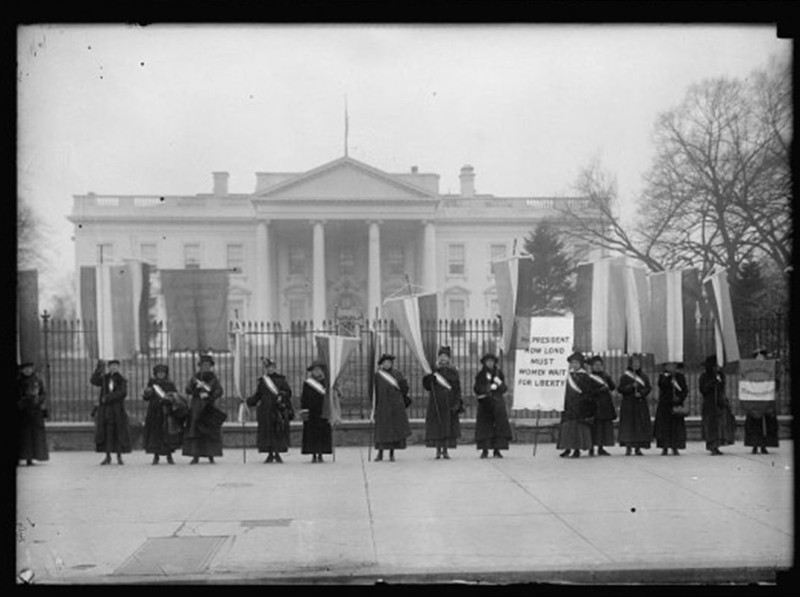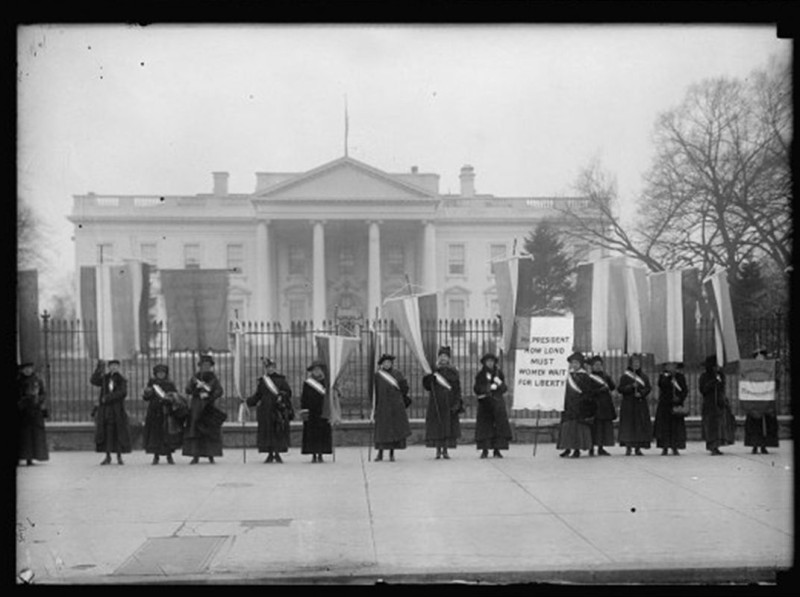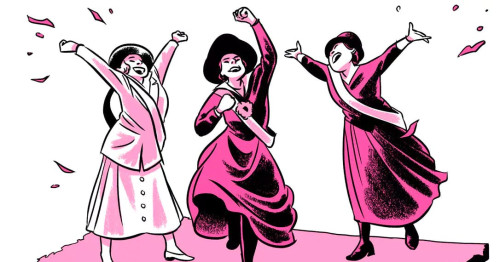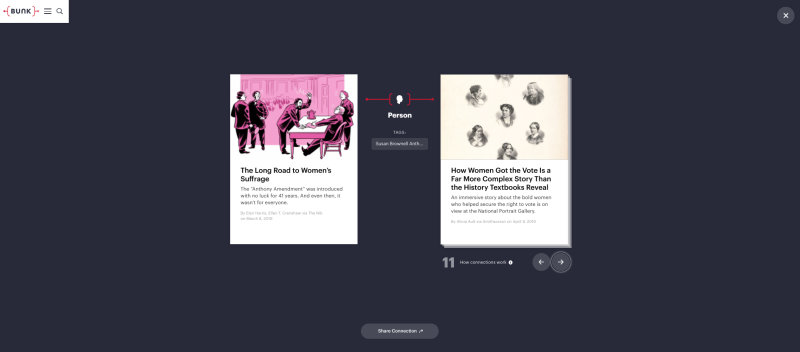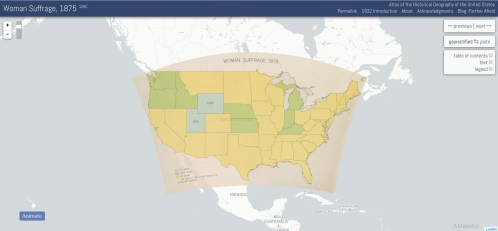This work by New American History is licensed under a Attribution-NonCommercial-ShareAlike 4.0 (CC BY-NC-SA 4.0) International License. Permissions beyond the scope of this license may be available at newamericanhistory.org.
The Fight for Women's Suffrage
Read for Understanding:
Most of us know that women have only been able to vote in the U.S. for just over one hundred years. But what about other issues of equality, such as jobs, pay and more? This lesson explores how the roles of women began to change as they advocated for equal rights, including suffrage, in the 20th century.
Key Vocabulary
Amendment - to officially change a document, law or policy, such as a Constitutional amendment
Georectify - the process of taking an image of a digital map and referencing it to a spatial grid, allowing the image of the map to be used as a layer in other digital maps
Infographic - a visual image such as a chart or diagram used to represent information or data
Material Culture - includes all the physical things that people create and attach meaning to, such as man-made and manufactured objects and buildings
Qualifications - having the skills and knowledge to perform a task or job
Ratify - to officially approve or vote into law, such as an amendment to the Constitution
Splinter Group - a small organization that becomes separated from or acts apart from an original larger group, often due to a disagreement.
Suffrage - the right to vote in political elections
Engage:
How long must women wait for liberty?
Examine this first image closely.
- What do you notice? (people, places, objects)
- Is there any text in the photo? If so, what new information does it help you discover about the image?
Now look more carefully at the image for clues about when and where it may have been taken. Use evidence to support your thinking about the image. Your teacher may allow you to work in pairs or on your own.
- If there are people in the image, what are they doing? How are they dressed?
- Do you notice anything about the image which may give you a clue about the location?
- What sort of material culture (objects, buildings) do you notice in the image?
- What clues does the image have to let you know when it may have been taken?
- Does the image have a caption? If not, what caption might you add to the image?
Now use the arrows on the sides of the image to look at the next image in the gallery. The image is the same, but this time there is a caption. Study the caption and consider the following:
- Where do you think the image was taken? Use a specific example to help support your answer.
- When do you think the image was taken? Note specific examples from the image which lead you to believe it was taken during a certain period in history.
- Why do you think the image was taken? For what purpose? Give an example of someone who might have taken this image or a similar one during this time.
Reflect on the image. What resources might you use to find out more information about the photo? Your school librarian/media specialist may help provide you with additional resources to explore on this topic. You may also explore bunkhistory.org!
Explore:
In what ways did the role of women begin to change as they advocated for equal rights, including suffrage, in the 20th century?
This episode of BackStory includes a segment on the 1913 Women’s Suffrage Parade in Washington, D.C. where Alice Paul organized a peaceful parade in support of women’s suffrage that marched women down Pennsylvania Avenue straight to the White House. But it didn’t stay peaceful for long. As you listen to this segment from the episode, your teacher may ask you to use this graphic organizer to help you organize your thinking about the topic.
After listening to the podcast, review the BackStory transcript and consider these statements you just heard: (Your teacher may have your work independently or with a partner. If working remotely, your teacher may provide a virtual option for collaboration.)
“In 1848, the historic women’s rights convention in Seneca Falls included suffrage in its declaration of rights.”
(In 1913) “Paul fought to secure a permit to march down America’s corridor of power, Pennsylvania Avenue, which connected the capitol and the White House.”
“Respectable white middle-class American women simply did not march in the street.”
“But the national splash of the 1913 parade, that really reinvigorated the suffrage movement. From almost nothing happening for a Federal amendment, a Federal amendment to the Constitution was achieved in 1920.”
- In what ways did the women’s suffrage movement change between the Seneca Falls Convention and the 1913 parade organized by the splinter group leader, Alice Paul?
- What did you find most surprising about author Jill Zahniser’s description of the events that occurred during the 1913 suffrage parade in Washington, D.C.?
- How did the politicians and police respond to the events of March 3, 1913?
- What kind of reaction did the suffragettes (women protesters) get from the crowd along the parade route?
- What levels of government were involved in the fight for women’s suffrage before it finally resulted in a Constitutional amendment?
- How does this compare to more recent events or movements you may have seen on the news or read about/seen in your communities?
Select another quote from the transcript, or by listening to the podcast again, sharing what made that quote memorable or interesting to you. Share the quote you selected with your teacher and classmates. Digital tools such as Google Docs or Google Slides may also be used for collaboration and sharing.
Your teacher may ask you to record your answers on an exit ticket.
Explain:
Can we separate the fight for women’s equality from other social movements?
The fight for women’s suffrage was not easy and certainly didn’t happen overnight. Many women (and some men!) fought for decades for women’s suffrage, sometimes putting themselves in harm’s way and making great sacrifices. To learn more about this important social movement, explore this excerpt of a comic from The Nib on Bunk History.
In the excerpt, you learn about Susan B. Anthony, an early suffragist, and her friends the Sargeants. Think about the roles each of these people played in this excerpt of the story.
- Who defended Susan B. Anthony when she was jailed for registering to vote?
- What role did Senator Sargeant play in the early suffrage movement?
- Which rights did he try to legislate for women?
- Why didn’t a woman propose these laws in Congress?
Now read the comic in its entirety using the “View on The Nib” button below the excerpt. When you are finished, return to Bunk using the back arrow in our web browser.
Turn and talk to a partner, or if working remotely, your teacher may provide opportunities to collaborate with classmates using video conferencing, access to an online chat feature, or breakout rooms.
In the comic, you read about many people who fought for decades to gain voting rights for women. Think about some of the ways each person contributed to this cause.
- What legislative actions did you read about in the fight for women’s suffrage?
- What examples of activism or protest were included in the comic?
- What were some of the barriers the suffragists faced?
- How did the movement grow or find support?
- Did some geographic regions seem to support women’s suffrage more than others?
- Who were the leaders of the movement?
- What group or groups seem to be missing from this narrative? Why?
Now study this panel from the comic.
- Interpret the statement, “But history is anything but convenient.”
- What new scholarship by historians has surfaced about Susan B. Anthony?
- Why did the Nevada City Council cancel plans to honor Senator Aaron A. Sargent, and his wife, Ellen Clark Sargent?
Return to the original excerpt on Bunk. Notice the icons (lightbulb, person, map pin, and/ or clock) and the stack of cards on the right side of the screen. These cards include other connections to the comic you read. The number below shows you how many connections there are for each icon. You can select the View Connections button and explore other articles related to the comic you read. These connections change as new content is added to Bunk each week.
Now explore this Bunk Connection. Notice the tags below the Idea icon. These tags help relate the connected ideas between these 2 excerpts. If you click on the tags, they show you other excerpts that explore similar tags. The stack of cards also changes, as does the number of connections. Select the article shown in this connection, “How Women Got the Vote Is a Far More Complex Story Than the History Textbooks Reveal.” This article may be a bit challenging to read. Try pasting each paragraph of the excerpt into the Rewordify app and follow along with the text, comparing the original for context.
- How does Rewordify help explain the main points of the article?
- What new information does the article share about the role of women in the suffrage movement?
- How does the article make you change your thinking about some of the leaders of the movement?
- Have social movements changed in more recent years in terms of being more inclusive?
If time permits, your teacher may allow you to explore additional Bunk Connections.
Your teacher may ask you to record your answers on an exit ticket.
Elaborate:
What role did geography play in the Women’s Suffrage movement?
Take a few minutes to explore this series of maps showing the history of Women’s Suffrage 1875-1920, from the Atlas of the Historical Geography of the United States.
This link takes you to the first map in the series of historical maps focusing on Women’s Suffrage from 1875-1920. Take a few minutes to study the map, and select different options/views. You may move the map around on the screen, and make it smaller or larger using the +/- buttons in the top right corner of the map. The slider tool next to the +/- buttons allow you to adjust the transparency of the map.
- What happens when you toggle back and forth between the georectified plate and the flat map? Try changing the transparency of the map using the slider tool.
- Review the vocabulary for the learning resources. How does the georectified map help us analyze the historical maps using digital tools?
- How does the map change when you select the table of contents on the map menu? The text features?
- Select the map key. Look carefully at how colors are used on the map.
Now select the blue “Animate” button in the bottom left corner of the map. Watch carefully as the map changes. Look for patterns on the map.
- Which regions/states began approving suffrage for women first?
- Which regions/ states seemed to continue to deny women the right to vote for the longest amount of time?
- Watch the animation a few times to continue to analyze and look for patterns. What do you notice?
- Why are some states not labeled on the maps?
- Use the text on the right side of the screen, and the ↞previous, next↠ button to scroll through each map, one at a time. What new information did you discover about the history of the Women’s suffrage movement?
- How did the maps provide additional information which agreed with the comic or Bunk excerpts you read in the earlier learning resources?
- Did any of the information in the text disagree with the comic or Bunk excerpts you read? If so, how might you find additional resources to help decide which version you find most historically accurate? (Your school librarian/media specialist may be very helpful as you search.)
- When did YOUR state first allow women the right to vote?
On June 5, 1919, a joint resolution of Congress proposed an amendment to the Constitution extending the right of suffrage to women. On August 26, 1920, Secretary of State the Secretary of State declared that the amendment had been ratified by three-fourths of the states and had become a part of the Constitution.
Some states have different rules or laws about how people can register to vote. Others have different rules about who can vote using an absentee ballot, including who, how, and when they may vote. Research these rules for your location.
Your teacher may ask you to record your answers on an exit ticket.
Extend:
What other data can we analyze to learn more about voting patterns in more recent times?
Infographics are everywhere! We see them in newspapers, online, in textbooks, and on television. Always look at the source of an infographic when you consider how the data may/may not be accurate. Your teacher or school librarian/media specialist can help you locate trusted sources for data and infographics.
Take a few minutes to explore this infographic.
Turn and talk to a partner, or if working remotely, your teacher may provide opportunities to collaborate with classmates using video conferencing, access to an online chat feature, or breakout rooms.
- What do you notice about the infographic?
- What trends do you see by gender?
- What trends do you see by race?
- What trends do you see by age?
- Is the data used to create the infographic from a reputable source?
- What was the purpose of creating the infographic?
Every four years voters return to the polls to vote for the next president, as well as other elected officials. Some states will also have state and local issues to vote on that may impact peoples’ daily lives. Noting the data on the infographic you just viewed, share your predictions for future elections. Cite specific examples from the infographic, maps, Bunk articles, and any images you have viewed in this learning resource or other trusted sources. Check back after the election to see how accurate your predictions turned out to be!
Your teacher may ask you to record your answers on an exit ticket.
Citations:
Bunk History. New American History. Accessed July 17, 2020. https://www.bunkhistory.org/resources/4046/connections?type=person&res=4141.
Charles O. Paullin, Atlas of the Historical Geography of the United States, ed. John K. Wright. Washington, D.C.: Carnegie Institution, 1932. Digital edition edited by Robert K. Nelson et al., 2013. http://dsl.richmond.edu/historicalatlas/.
Harris, Eleri, and Ellen T. Crenshaw . “The Long Road to Women's Suffrage,” March 8, 2019. https://www.bunkhistory.org/resources/4046.
Nav, Diane. “Gender Difference Voter Turnout in 2016 Presidential Election.” Web Design & Interactive Media. Wordpress, January 30, 2020. https://dig3110.wordpress.com/2020/01/30/gender-difference-voter-turnout-in-2016-presidential-election/.
“VA Foundation for the Humanities | You've Come A Long Way ...” BackStory. Virginia Humanities, July 29, 2016. https://www.backstoryradio.org/shows/youve-come-a-long-way.


